SIMLESA: Celebrating two years of achievements, defining the future
During 19-23 March 2012, over 200 researchers, policy makers, donors, seed specialists, and NGO representatives from Africa and Australia gathered in Arusha, Tanzania, for the second SIMLESA (Sustainable Intensification of Maize-Legume Cropping Systems for Food Security in Eastern and Southern Africa) Annual Regional Planning and Review Meeting. Representation from the Australian Centre for International Agriculture Research (ACIAR), which generously supports the work, included nine members of the organization’s Commission for International Agricultural Research.
Participants shared lessons from the last two years and discussed better ways to design and implement future activities. Ten sessions addressed issues including project implementation, Australian-African partnerships, program and partner progress and lessons, and communications and knowledge management.

A key message was that SIMLESA had consolidated and strengthened activities across all objectives, maximizing gains from integration, innovation, information, and technology diffusion for greater impacts on livelihoods and agroecosystems. It was noted that the use of integrated systems can foster productive intensification of agriculture and, indeed, the Innovation Platform Framework, supported by science and partnerships, can contribute to productive, sustainable and resilient maize-legume systems. For even greater impact, the program should rely on stronger leadership from agribusiness, while supporting the public sector’s role, and ensure a farm-income focus to reduce poverty.
Another key message was to strengthen Australian-African partnerships through better delivery of research products, capacity building under any of ACIAR’s four thematic areas, bridging research and extension, strengthening policy and socioeconomic research, and building individual and institutional capacity.
 Speaking at the SIMLESA’s second “birthday party,” Joana Hewitt, chairperson of the ACIAR Commission for International Agricultural Research, reiterated the Australian government’s commitment to long-term partnerships with African governments. Participants also heard of the new SIMLESA Program in Zimbabwe, focusing on crop-livestock interactions. During the dinner, Kenya and Mozambique were recognized for their efforts in promoting and strengthening local innovation platforms.
Speaking at the SIMLESA’s second “birthday party,” Joana Hewitt, chairperson of the ACIAR Commission for International Agricultural Research, reiterated the Australian government’s commitment to long-term partnerships with African governments. Participants also heard of the new SIMLESA Program in Zimbabwe, focusing on crop-livestock interactions. During the dinner, Kenya and Mozambique were recognized for their efforts in promoting and strengthening local innovation platforms.
In addition to SIMLESA’s program steering committee and the mid-term review team, the event drew representatives from USAID’s Farmer-to-Farmer Program, from the International Development Research Centre (IDRC), the African Agriculture Technology Foundation (AATF), the International Livestock Research Institute (ILRI), and the Agricultural Research Council (ARC) of South Africa. SIMLESA is centered in five countries— Ethiopia, Kenya, Tanzania, Malawi, and Mozambique—with spillovers benefiting Uganda, Sudan, and Zambia. Representatives from all those countries interacted at the meeting.
A SIMLESA “village” and poster presentations allowed partner representatives and researchers to showcase achievements, and visits to Karatu and Mbulu—Tanzanian sites where SIMLESA is present— demonstrated how the project is transforming agriculture.
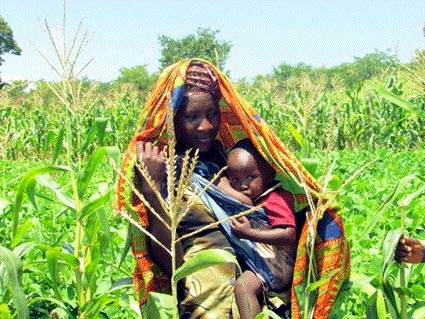 In February 2012 several CIMMYT staff working in
In February 2012 several CIMMYT staff working in 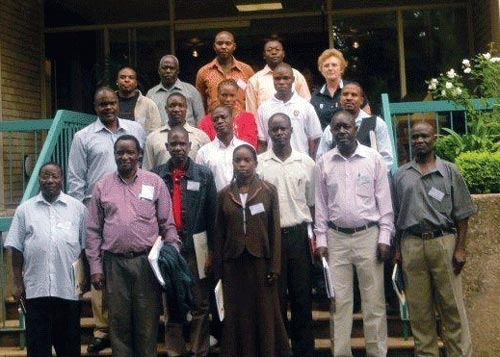
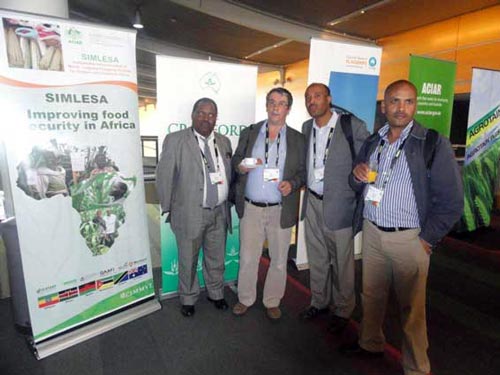 SIMLESA is funded by the Australian Center for International Agricultural Research (ACIAR), and led by CIMMYT. It is being implemented in collaboration with the national agricultural research systems of Ethiopia, Kenya, Malawi, Mozambique, and Tanzania; the International Crops Research Institute for the Semi-Arid Tropics (ICRISAT); and Australian partners including the Queensland Department of Employment, Economic Development and Innovation (QDEEDI), Murdoc University, and the University of Queensland. These partnerships with Australian universities, as well as with universities in Africa, have been key to building capacity through short-term training and postgraduate fellowships for researchers. Adopting the Innovation Platform framework, further co-operation with a range of private and public sector organizations, NGOs, and famers’ organizations in Africa has meant the project has been able to quickly and effectively reach farmers on the ground with outputs such as varieties and technologies.
SIMLESA is funded by the Australian Center for International Agricultural Research (ACIAR), and led by CIMMYT. It is being implemented in collaboration with the national agricultural research systems of Ethiopia, Kenya, Malawi, Mozambique, and Tanzania; the International Crops Research Institute for the Semi-Arid Tropics (ICRISAT); and Australian partners including the Queensland Department of Employment, Economic Development and Innovation (QDEEDI), Murdoc University, and the University of Queensland. These partnerships with Australian universities, as well as with universities in Africa, have been key to building capacity through short-term training and postgraduate fellowships for researchers. Adopting the Innovation Platform framework, further co-operation with a range of private and public sector organizations, NGOs, and famers’ organizations in Africa has meant the project has been able to quickly and effectively reach farmers on the ground with outputs such as varieties and technologies.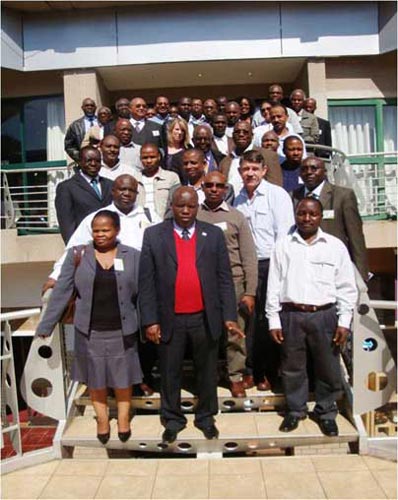 Edison Wotho, Deputy Permanent Secretary, Ministry of Agriculture, Botswana, praised Botswana’s participation in NSIMA, whose products for that country’s farmers include a new drought tolerant maize hybrid (CZH0623) and three OPVs (ZM309, ZM401 and ZM523). “The projects come at the right time,” said Wotho. “The region is experiencing frequent droughts and food shortages.”
Edison Wotho, Deputy Permanent Secretary, Ministry of Agriculture, Botswana, praised Botswana’s participation in NSIMA, whose products for that country’s farmers include a new drought tolerant maize hybrid (CZH0623) and three OPVs (ZM309, ZM401 and ZM523). “The projects come at the right time,” said Wotho. “The region is experiencing frequent droughts and food shortages.”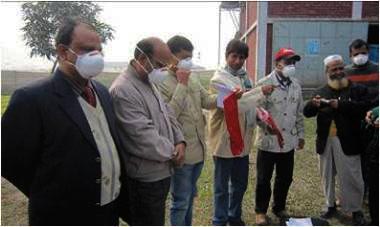 In Bangladesh, approximately 350 species of weeds have been identified, and in Asian countries, these weeds cause roughly 33% of total crop loss. Because of the threat posed by weeds, the use of herbicides in Bangladesh has risen rapidly in the past few years. Herbicides are a great asset to protect crops from weeds; however when not used properly, they can be dangerous to human health or lead to the premature development of herbicide-resistant weeds.
In Bangladesh, approximately 350 species of weeds have been identified, and in Asian countries, these weeds cause roughly 33% of total crop loss. Because of the threat posed by weeds, the use of herbicides in Bangladesh has risen rapidly in the past few years. Herbicides are a great asset to protect crops from weeds; however when not used properly, they can be dangerous to human health or lead to the premature development of herbicide-resistant weeds. Over 60 researchers, field technicians, farmers, machinery manufacturers, service providers, and extension workers attended two recent conservation agriculture (CA) training events in Bangladesh. The first event was held at the Bangladesh Agriculture Research Institute (BARI) station in Comilla on 28-29 April, followed by an event at the Wheat Research Centre of BARI in Dinajpur on 04-05 May. The events focused on machinery operation and maintenance, as well as the agronomy of dry direct-seeded rice (DSR). Both were part of joint CIMMYT-
Over 60 researchers, field technicians, farmers, machinery manufacturers, service providers, and extension workers attended two recent conservation agriculture (CA) training events in Bangladesh. The first event was held at the Bangladesh Agriculture Research Institute (BARI) station in Comilla on 28-29 April, followed by an event at the Wheat Research Centre of BARI in Dinajpur on 04-05 May. The events focused on machinery operation and maintenance, as well as the agronomy of dry direct-seeded rice (DSR). Both were part of joint CIMMYT-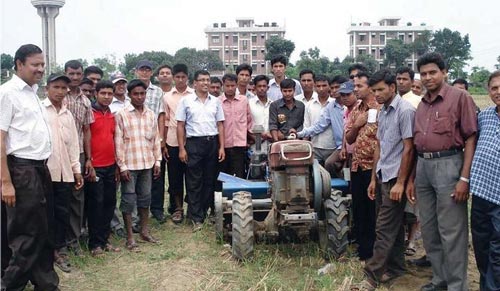 “Machinery operation and maintenance is vital for rapid dissemination of CA-based technologies,” said Jagadish Timsina, IRRI-CIMMYT senior cropping system agronomist. He added that this ACIAR-funded ricemaize project has been adapting and evaluating the PTOS and the bed former/planter at project sites, and has been refining these machines for their use in different soils with the help of agriculture engineers from the national agriculture research intuitions involved in the project. The project has given special emphasis to training and capacity building for machine use and has already trained more than 120 people from government and non-governmental organizations, as well as farmers, service providers, machinery manufacturers, and extension workers since it started in November 2008.
“Machinery operation and maintenance is vital for rapid dissemination of CA-based technologies,” said Jagadish Timsina, IRRI-CIMMYT senior cropping system agronomist. He added that this ACIAR-funded ricemaize project has been adapting and evaluating the PTOS and the bed former/planter at project sites, and has been refining these machines for their use in different soils with the help of agriculture engineers from the national agriculture research intuitions involved in the project. The project has given special emphasis to training and capacity building for machine use and has already trained more than 120 people from government and non-governmental organizations, as well as farmers, service providers, machinery manufacturers, and extension workers since it started in November 2008. Various research and extensions workers collaborating with the project “Sustainable Intensification of Rice-Maize Systems in Bangladesh” organized five farmer field days throughout March and April 2010. The events took place in the districts of Comilla, Rangpur, and Rajshahi and attracted over 350 farmers.
Various research and extensions workers collaborating with the project “Sustainable Intensification of Rice-Maize Systems in Bangladesh” organized five farmer field days throughout March and April 2010. The events took place in the districts of Comilla, Rangpur, and Rajshahi and attracted over 350 farmers.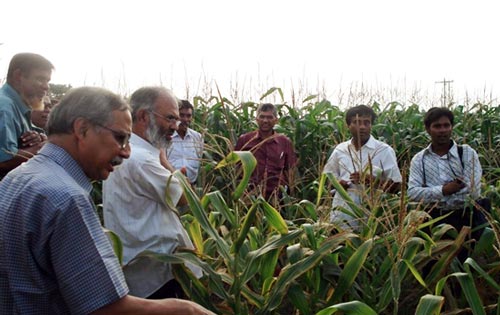 Though the project, which started in November 2008, initially focused on adaptive research in farmers’ fields, it is now starting to emphasize dissemination of improved CA practicies and SSNM technologies to farmers as well. This will be done through training and capacity building with researchers, farmers, extension workers, machinery manufacturers, and service providers.
Though the project, which started in November 2008, initially focused on adaptive research in farmers’ fields, it is now starting to emphasize dissemination of improved CA practicies and SSNM technologies to farmers as well. This will be done through training and capacity building with researchers, farmers, extension workers, machinery manufacturers, and service providers.